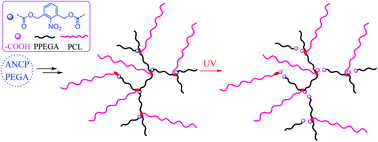Youliang Zhao*a(赵优良)
a Suzhou Key Laboratory of Macromolecular Design and Precision Synthesis, Jiangsu Key Laboratory of Advanced Functional Polymer Design and Application, College of Chemistry, Chemical Engineering and Materials Science, Soochow University, Suzhou 215123, China
b College of Textile and Clothing Engineering, Soochow University, Suzhou 215123, China
Polym. Chem. 2015, 6, 3489-3501
Different from hyperbranched star-like polymers and dendritic brushes, dendritic-unit-bridged hyperbranched graft copolymers (DHGCs) with branching point linked branches and linear grafts can be regarded as a new subclass of hyperbranched-graft-linear copolymers. This study aims at the synthesis and properties of photocleavable DHGCs comprising oligomeric branches composed of poly(ethylene glycol) methyl ether acrylate (PEGA) units, linear poly(ε-caprolactone) (PCL) grafts and o-nitrobenzyl ester (ONBE) moieties in the dendritic unit. Based on a multifunctional inimer 3-((2-acryloyloxymethyl-2-hydroxymethyl)propionyloxy)methyl-2-nitrobenzyl 4-cyano-4-(phenylcarbonothioylthio)pentanoate (ANCP), functional DHGCs were controllably synthesized via two step reactions. RAFT copolymerization afforded hyperbranched poly(ANCP-co-PEGA) (PAP), followed by CL polymerization to achieve PAP-g-PCL. Upon photo-cleavage, hyperbranched PAP was converted into linear polymers, and PAP-g-PCL was readily degraded into mixtures of linear, star and graft polymers. With increasing UV irradiation time, the PAP-g-PCL micelles were gradually evolved into vesicles and multicompartment vesicles due to photo-triggered cleavage and reaggregation. Upon normal and on-demand UV irradiation, the release kinetics for controlled release of Nile red from copolymer aggregates could be tuned in a wide range, revealing the great potential in smart drug delivery systems. This study affords a versatile method to construct photolabile DHGCs, which opens up a new route to explore unique properties of novel topological copolymers.

链接:
//pubs.rsc.org/en/Content/ArticleLanding/2015/PY/c5py00132c#!divAbstract